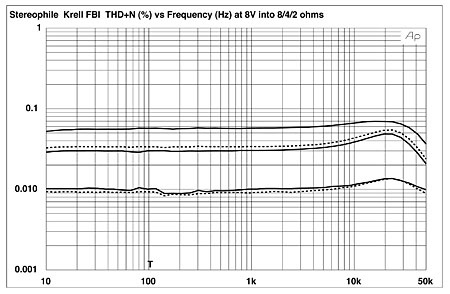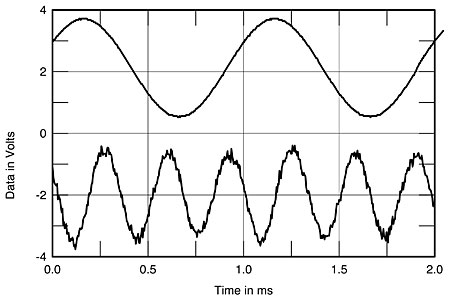| Columns Retired Columns & Blogs |
And putting both pre- and power amp in a single chassis cuts down on storage. - Reba Rambo-McGuire
Before performing any test on an amplifier, I precondition it by running both channels for 60 minutes at one-third the specified power into 8 ohms, which is thermally the worst case for an amplifier with a class-B or-AB output stage. At the end of that hour, the Krell FBI's entire chassis—not just the large vertical heatsinks on its sides—was too hot to touch. This is an amplifier that needs plenty of ventilation. The THD+noise percentage with the amplifier stone cold was 0.0142%; by the end of the hour's warmup, this had dropped to 0.0067%.
Without a signal generator having a current-source output, I couldn't perform any tests using the FBI's current-mode (CAST) input; instead, I used its conventional balanced and unbalanced inputs. Looking first at the preamplifier outputs, these offered a sensible maximum gain of 4dB for an unbalanced signal, sourced from a constant 100 ohms across the audioband. The FBI as a whole offered a maximum gain of 36.4dB into 8 ohms with both balanced and unbalanced sources, which is as specified but lower than usual for an integrated amplifier. The input impedance was extremely high across most of the audioband, at 200k ohms unbalanced and 400k ohms balanced, these figures dropping slightly but inconsequentially at 20kHz. (These values are approximate, given the degree of uncertainty in measuring very high impedances using our usual voltage-drop method.) All inputs preserved absolute polarity; ie, were non-inverting.
The output impedance (including 6' of speaker cable) was very low, at 0.08 ohm at low and midrange frequencies. It rose very slightly, to 0.11 ohm at 20kHz, but this will be inconsequential. The modification of the amplifier's frequency response due to the interaction between its source impedance and the modulus of the speaker's impedance was less than ±0.05dB (fig.1, top trace at 2kHz). This graph also shows that the small-signal audioband response is flat, with a sensible ultrasonic rolloff reaching –3dB at 122kHz. This bandwidth was identical with both balanced and unbalanced sources, and didn't change with the volume-control setting. The FBI's reproduction of a 10kHz squarewave featured very short risetimes and was commendably free from overshoot and ringing (fig.2). The 1kHz squarewave (not shown) was perfectly, er, square.

Fig.1 Krell FBI, frequency response at 2.83V into (from top to bottom at 2kHz): simulated loudspeaker load, 8, 4, 2 ohms (0.5dB/vertical div., right channel dashed).

Fig.2 Krell FBI, small-signal 10kHz squarewave into 8 ohms.
Channel separation was very good, at better than 96dB below 1kHz, though it did decrease 76dB at 20kHz, due to the usual capacitive coupling. The wideband, unweighted signal/noise ratio with the input shorted but the volume control set to its maximum was a good 76.5dB ref. 2.83V into 8 ohms, this improving to 87.1dB when A-weighted, which is close to the specified 108dBA ref. clipping power when you add the amplifier's voltage gain to the 2.83V figure.
The FBI is specified as being able to deliver 300Wpc into 8 ohms (24.8dBW). However, plotting the output power against the THD+N percentage (fig.3) shows that the FBI actually delivered 430Wpc into 8 ohms at 1% THD, which is a significant 1.6dBW higher. With both channels driven, the amplifier clipped at 667W into 4 ohms (25.2dBW). Even though the clipping power with one channel driven into 2 ohms was 1020W (24.05dBW), slightly below the specified 1200W, I don't keep my AC wall voltage consistent for this test, which had drooped with the amplifier's current draw. The FBI will deliver all the power anyone could need.

Fig.3 Krell FBI, distortion (%)vs 1kHz continuous output power into (from bottom to top at 100W): 8, 4, 2 ohms.
Note from fig.3 that the THD level above a handful of watts into the lower impedances is higher than into 8 ohms. This can also be seen in fig.4, which plots the THD+N percentage against frequency at 8V, a level where the actual distortion is about to emerge from the background noise. The THD doubles with each halving of the load impedance, though in absolute terms it does remain low overall. There is only a small rise in the top two octaves of the graph, suggesting that the Krell FBI has a commendably wide open-loop bandwidth.

Fig.4 Krell FBI, THD+N (%)vs frequency at 8V into (from bottom to top): 8, 4, 2 ohms (right channel dashed).
At moderate power levels into 8 ohms (fig.5) the distortion's harmonic content is almost pure third harmonic, which will be subjectively innocuous. Even at one-third the clipping power (fig.6), only the third harmonic is evident. However, not only does the third harmonic rise when the load impedance is reduced, the fifth and seventh harmonics appear (fig.7), though it's fair to say that these remain low in absolute terms. And even with an equal mix of 19 and 20kHz tones close to clipping into 4 ohms, intermodulation distortion remains very low (fig.8).

Fig.5 Krell FBI, 1kHz waveform at 13W into 8 ohms (top), 0.00975% THD+N; distortion and noise waveform with fundamental notched out (bottom, not to scale).

Fig.6 Krell FBI, spectrum of 50Hz sinewave, DC–1kHz, at 120W into 8 ohms (linear frequency scale).

Fig.7 Krell FBI, spectrum of 50Hz sinewave, DC–1kHz, at 234W into 4 ohms (linear frequency scale).

Fig.8 Krell FBI, HF intermodulation spectrum, DC–24kHz, 19+20kHz at 550W peak into 4 ohms (linear frequency scale).
It was a pleasure to measure such a well-engineered amplifier as Krell's FBI. Quiet, powerful, stable, and well-behaved even into low impedances, it is a paradigm of what an integrated amplifier needs to do. If only it weren't quite so heavy—carrying it down the steps of Fred's brownstone to my car, then down the stairs from my driveway to my test lab, I began to appreciate the virtues of amps with featherweight class-D output stages!—John Atkinson

And putting both pre- and power amp in a single chassis cuts down on storage. - Reba Rambo-McGuire